Contemporary People Management: Utilitarianism, HRM & CPM Practices
VerifiedAdded on 2023/06/04
|7
|2183
|489
Essay
AI Summary
This essay explores the relationship between contemporary people management (CPM), human resource management (HRM), and the utilitarian theory of ethics, focusing on the pursuit of human happiness in organizational practices. It examines how the utilitarian theory, which prioritizes actions that maximize happiness for the greatest number of people, relates to HRM and CPM strategies. The essay discusses the importance of ethical considerations in management, emphasizing the need for HR leaders to balance organizational goals with employee satisfaction and well-being. It also highlights the potential challenges and criticisms of utilitarianism, such as overlooking individual rights and ethical implications. The essay concludes by underscoring the crucial role of HR managers in creating policies that promote both organizational success and employee happiness, aligning with ethical principles and codes of conduct. Desklib provides a platform for students to access this essay and numerous other resources for their studies.
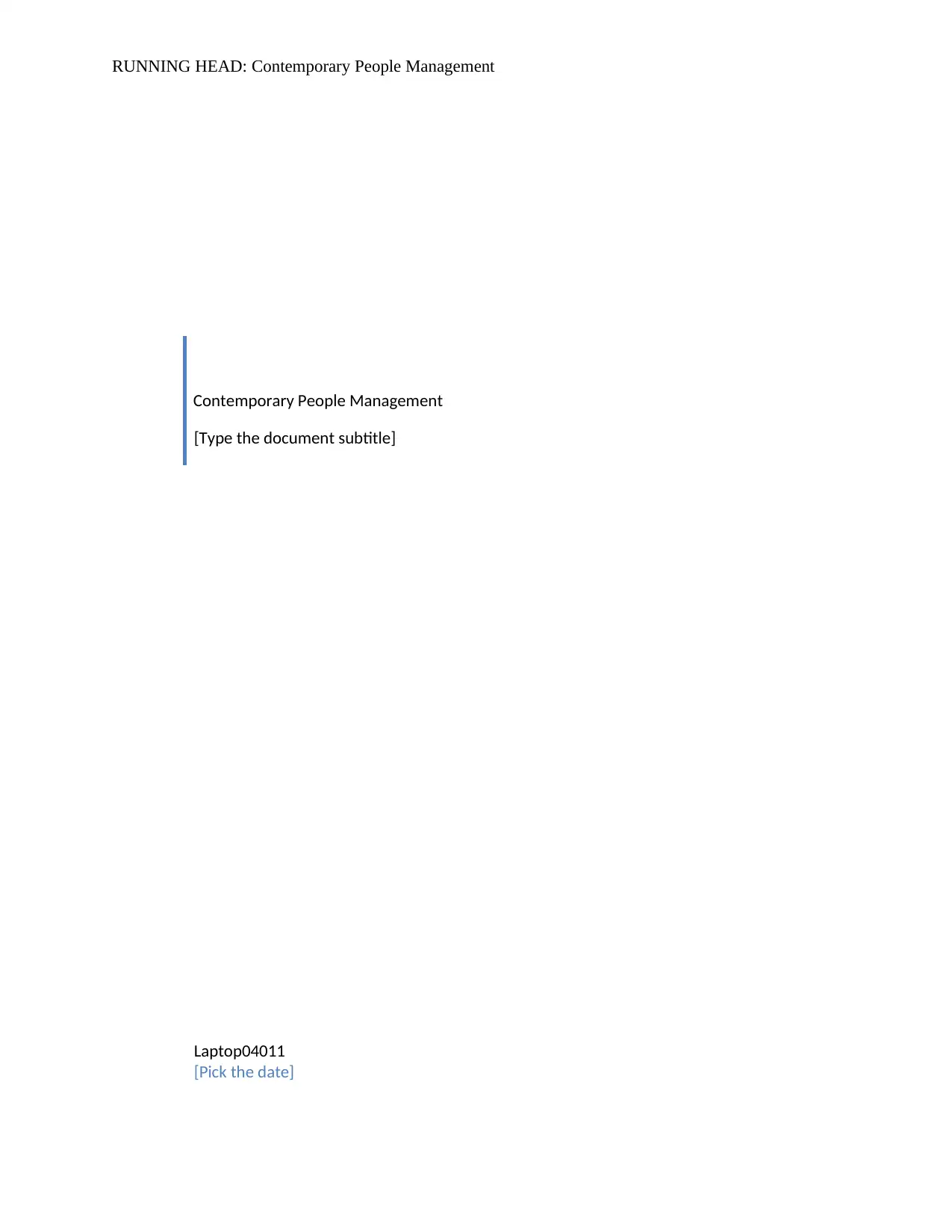
RUNNING HEAD: Contemporary People Management
Contemporary People Management
[Type the document subtitle]
Laptop04011
[Pick the date]
Contemporary People Management
[Type the document subtitle]
Laptop04011
[Pick the date]
Paraphrase This Document
Need a fresh take? Get an instant paraphrase of this document with our AI Paraphraser
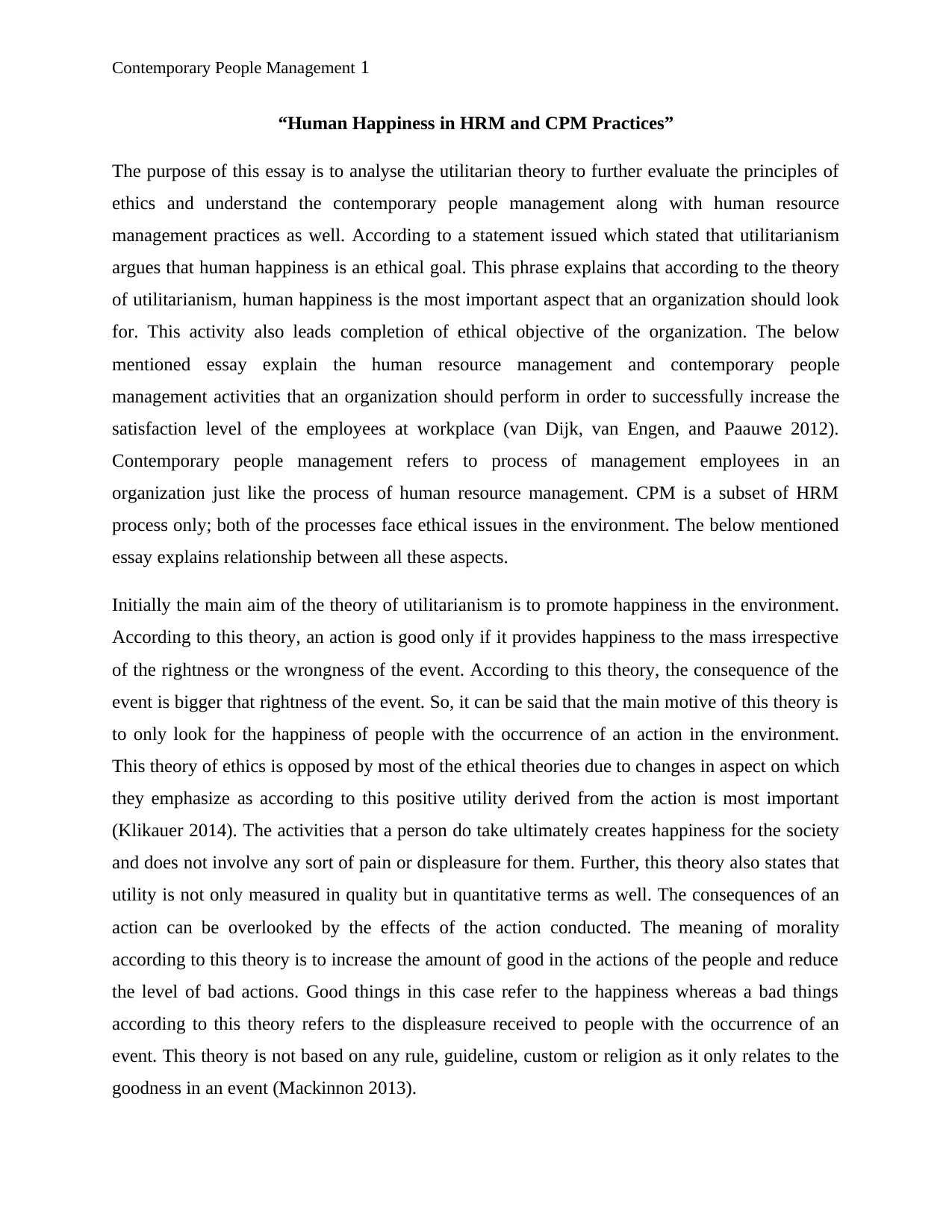
Contemporary People Management 1
“Human Happiness in HRM and CPM Practices”
The purpose of this essay is to analyse the utilitarian theory to further evaluate the principles of
ethics and understand the contemporary people management along with human resource
management practices as well. According to a statement issued which stated that utilitarianism
argues that human happiness is an ethical goal. This phrase explains that according to the theory
of utilitarianism, human happiness is the most important aspect that an organization should look
for. This activity also leads completion of ethical objective of the organization. The below
mentioned essay explain the human resource management and contemporary people
management activities that an organization should perform in order to successfully increase the
satisfaction level of the employees at workplace (van Dijk, van Engen, and Paauwe 2012).
Contemporary people management refers to process of management employees in an
organization just like the process of human resource management. CPM is a subset of HRM
process only; both of the processes face ethical issues in the environment. The below mentioned
essay explains relationship between all these aspects.
Initially the main aim of the theory of utilitarianism is to promote happiness in the environment.
According to this theory, an action is good only if it provides happiness to the mass irrespective
of the rightness or the wrongness of the event. According to this theory, the consequence of the
event is bigger that rightness of the event. So, it can be said that the main motive of this theory is
to only look for the happiness of people with the occurrence of an action in the environment.
This theory of ethics is opposed by most of the ethical theories due to changes in aspect on which
they emphasize as according to this positive utility derived from the action is most important
(Klikauer 2014). The activities that a person do take ultimately creates happiness for the society
and does not involve any sort of pain or displeasure for them. Further, this theory also states that
utility is not only measured in quality but in quantitative terms as well. The consequences of an
action can be overlooked by the effects of the action conducted. The meaning of morality
according to this theory is to increase the amount of good in the actions of the people and reduce
the level of bad actions. Good things in this case refer to the happiness whereas a bad things
according to this theory refers to the displeasure received to people with the occurrence of an
event. This theory is not based on any rule, guideline, custom or religion as it only relates to the
goodness in an event (Mackinnon 2013).
“Human Happiness in HRM and CPM Practices”
The purpose of this essay is to analyse the utilitarian theory to further evaluate the principles of
ethics and understand the contemporary people management along with human resource
management practices as well. According to a statement issued which stated that utilitarianism
argues that human happiness is an ethical goal. This phrase explains that according to the theory
of utilitarianism, human happiness is the most important aspect that an organization should look
for. This activity also leads completion of ethical objective of the organization. The below
mentioned essay explain the human resource management and contemporary people
management activities that an organization should perform in order to successfully increase the
satisfaction level of the employees at workplace (van Dijk, van Engen, and Paauwe 2012).
Contemporary people management refers to process of management employees in an
organization just like the process of human resource management. CPM is a subset of HRM
process only; both of the processes face ethical issues in the environment. The below mentioned
essay explains relationship between all these aspects.
Initially the main aim of the theory of utilitarianism is to promote happiness in the environment.
According to this theory, an action is good only if it provides happiness to the mass irrespective
of the rightness or the wrongness of the event. According to this theory, the consequence of the
event is bigger that rightness of the event. So, it can be said that the main motive of this theory is
to only look for the happiness of people with the occurrence of an action in the environment.
This theory of ethics is opposed by most of the ethical theories due to changes in aspect on which
they emphasize as according to this positive utility derived from the action is most important
(Klikauer 2014). The activities that a person do take ultimately creates happiness for the society
and does not involve any sort of pain or displeasure for them. Further, this theory also states that
utility is not only measured in quality but in quantitative terms as well. The consequences of an
action can be overlooked by the effects of the action conducted. The meaning of morality
according to this theory is to increase the amount of good in the actions of the people and reduce
the level of bad actions. Good things in this case refer to the happiness whereas a bad things
according to this theory refers to the displeasure received to people with the occurrence of an
event. This theory is not based on any rule, guideline, custom or religion as it only relates to the
goodness in an event (Mackinnon 2013).
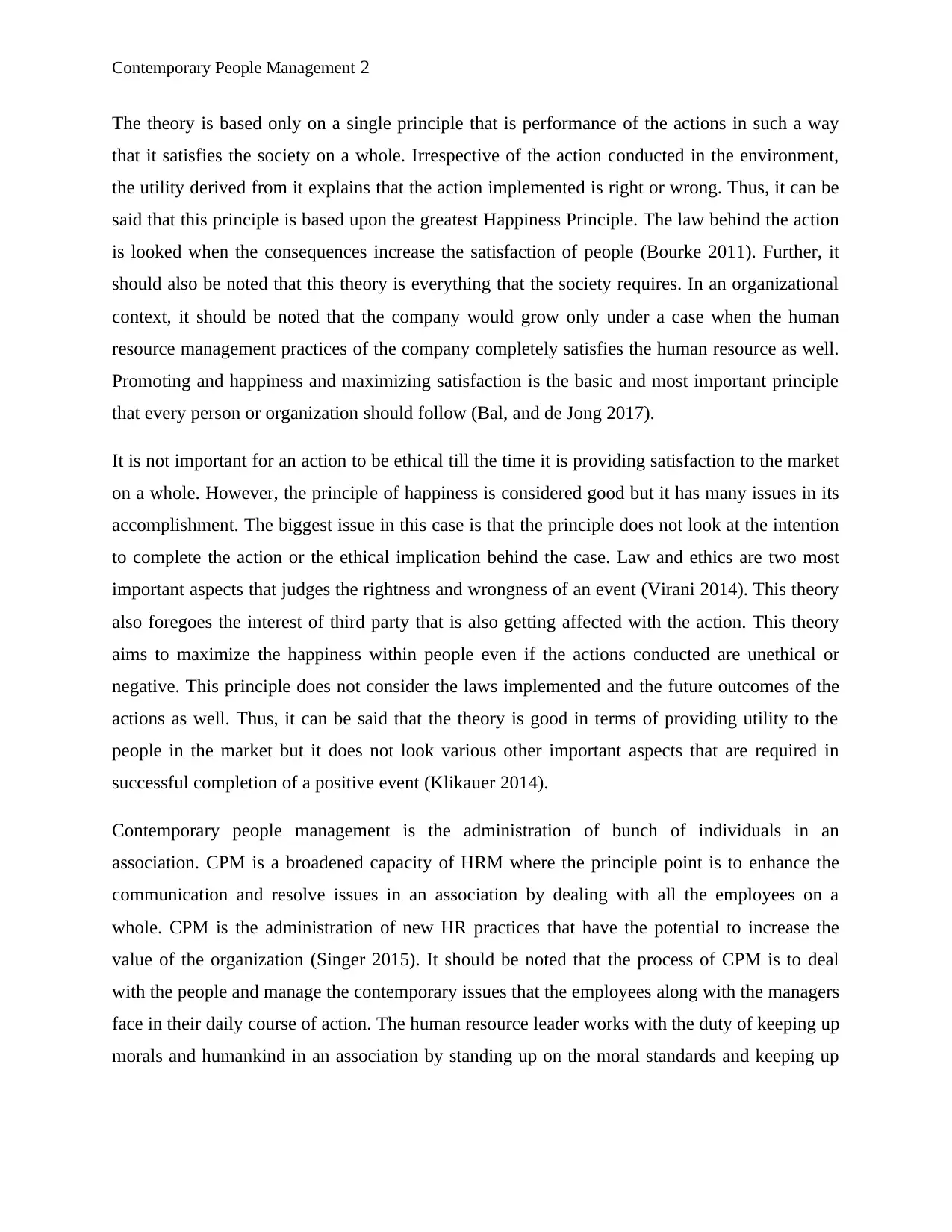
Contemporary People Management 2
The theory is based only on a single principle that is performance of the actions in such a way
that it satisfies the society on a whole. Irrespective of the action conducted in the environment,
the utility derived from it explains that the action implemented is right or wrong. Thus, it can be
said that this principle is based upon the greatest Happiness Principle. The law behind the action
is looked when the consequences increase the satisfaction of people (Bourke 2011). Further, it
should also be noted that this theory is everything that the society requires. In an organizational
context, it should be noted that the company would grow only under a case when the human
resource management practices of the company completely satisfies the human resource as well.
Promoting and happiness and maximizing satisfaction is the basic and most important principle
that every person or organization should follow (Bal, and de Jong 2017).
It is not important for an action to be ethical till the time it is providing satisfaction to the market
on a whole. However, the principle of happiness is considered good but it has many issues in its
accomplishment. The biggest issue in this case is that the principle does not look at the intention
to complete the action or the ethical implication behind the case. Law and ethics are two most
important aspects that judges the rightness and wrongness of an event (Virani 2014). This theory
also foregoes the interest of third party that is also getting affected with the action. This theory
aims to maximize the happiness within people even if the actions conducted are unethical or
negative. This principle does not consider the laws implemented and the future outcomes of the
actions as well. Thus, it can be said that the theory is good in terms of providing utility to the
people in the market but it does not look various other important aspects that are required in
successful completion of a positive event (Klikauer 2014).
Contemporary people management is the administration of bunch of individuals in an
association. CPM is a broadened capacity of HRM where the principle point is to enhance the
communication and resolve issues in an association by dealing with all the employees on a
whole. CPM is the administration of new HR practices that have the potential to increase the
value of the organization (Singer 2015). It should be noted that the process of CPM is to deal
with the people and manage the contemporary issues that the employees along with the managers
face in their daily course of action. The human resource leader works with the duty of keeping up
morals and humankind in an association by standing up on the moral standards and keeping up
The theory is based only on a single principle that is performance of the actions in such a way
that it satisfies the society on a whole. Irrespective of the action conducted in the environment,
the utility derived from it explains that the action implemented is right or wrong. Thus, it can be
said that this principle is based upon the greatest Happiness Principle. The law behind the action
is looked when the consequences increase the satisfaction of people (Bourke 2011). Further, it
should also be noted that this theory is everything that the society requires. In an organizational
context, it should be noted that the company would grow only under a case when the human
resource management practices of the company completely satisfies the human resource as well.
Promoting and happiness and maximizing satisfaction is the basic and most important principle
that every person or organization should follow (Bal, and de Jong 2017).
It is not important for an action to be ethical till the time it is providing satisfaction to the market
on a whole. However, the principle of happiness is considered good but it has many issues in its
accomplishment. The biggest issue in this case is that the principle does not look at the intention
to complete the action or the ethical implication behind the case. Law and ethics are two most
important aspects that judges the rightness and wrongness of an event (Virani 2014). This theory
also foregoes the interest of third party that is also getting affected with the action. This theory
aims to maximize the happiness within people even if the actions conducted are unethical or
negative. This principle does not consider the laws implemented and the future outcomes of the
actions as well. Thus, it can be said that the theory is good in terms of providing utility to the
people in the market but it does not look various other important aspects that are required in
successful completion of a positive event (Klikauer 2014).
Contemporary people management is the administration of bunch of individuals in an
association. CPM is a broadened capacity of HRM where the principle point is to enhance the
communication and resolve issues in an association by dealing with all the employees on a
whole. CPM is the administration of new HR practices that have the potential to increase the
value of the organization (Singer 2015). It should be noted that the process of CPM is to deal
with the people and manage the contemporary issues that the employees along with the managers
face in their daily course of action. The human resource leader works with the duty of keeping up
morals and humankind in an association by standing up on the moral standards and keeping up
⊘ This is a preview!⊘
Do you want full access?
Subscribe today to unlock all pages.

Trusted by 1+ million students worldwide
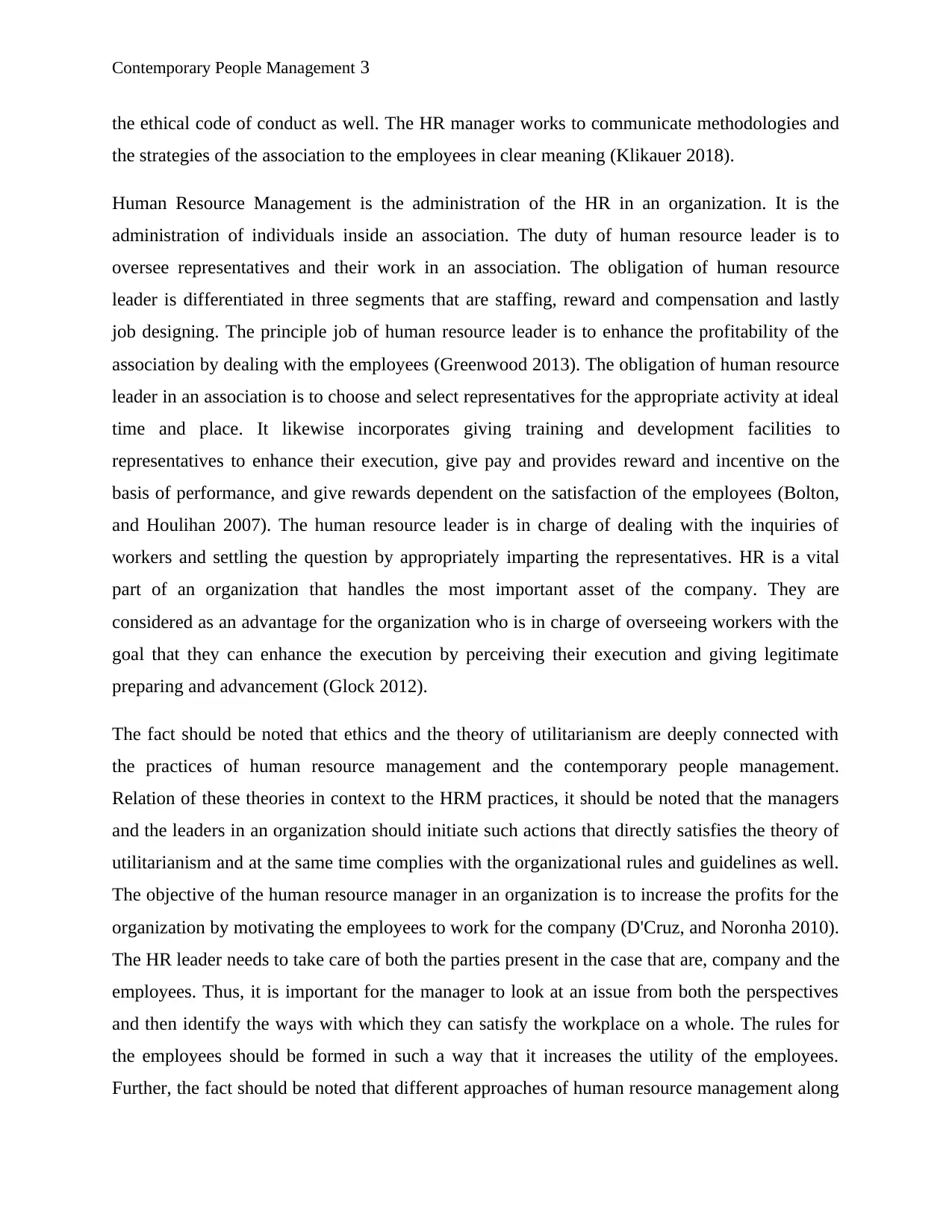
Contemporary People Management 3
the ethical code of conduct as well. The HR manager works to communicate methodologies and
the strategies of the association to the employees in clear meaning (Klikauer 2018).
Human Resource Management is the administration of the HR in an organization. It is the
administration of individuals inside an association. The duty of human resource leader is to
oversee representatives and their work in an association. The obligation of human resource
leader is differentiated in three segments that are staffing, reward and compensation and lastly
job designing. The principle job of human resource leader is to enhance the profitability of the
association by dealing with the employees (Greenwood 2013). The obligation of human resource
leader in an association is to choose and select representatives for the appropriate activity at ideal
time and place. It likewise incorporates giving training and development facilities to
representatives to enhance their execution, give pay and provides reward and incentive on the
basis of performance, and give rewards dependent on the satisfaction of the employees (Bolton,
and Houlihan 2007). The human resource leader is in charge of dealing with the inquiries of
workers and settling the question by appropriately imparting the representatives. HR is a vital
part of an organization that handles the most important asset of the company. They are
considered as an advantage for the organization who is in charge of overseeing workers with the
goal that they can enhance the execution by perceiving their execution and giving legitimate
preparing and advancement (Glock 2012).
The fact should be noted that ethics and the theory of utilitarianism are deeply connected with
the practices of human resource management and the contemporary people management.
Relation of these theories in context to the HRM practices, it should be noted that the managers
and the leaders in an organization should initiate such actions that directly satisfies the theory of
utilitarianism and at the same time complies with the organizational rules and guidelines as well.
The objective of the human resource manager in an organization is to increase the profits for the
organization by motivating the employees to work for the company (D'Cruz, and Noronha 2010).
The HR leader needs to take care of both the parties present in the case that are, company and the
employees. Thus, it is important for the manager to look at an issue from both the perspectives
and then identify the ways with which they can satisfy the workplace on a whole. The rules for
the employees should be formed in such a way that it increases the utility of the employees.
Further, the fact should be noted that different approaches of human resource management along
the ethical code of conduct as well. The HR manager works to communicate methodologies and
the strategies of the association to the employees in clear meaning (Klikauer 2018).
Human Resource Management is the administration of the HR in an organization. It is the
administration of individuals inside an association. The duty of human resource leader is to
oversee representatives and their work in an association. The obligation of human resource
leader is differentiated in three segments that are staffing, reward and compensation and lastly
job designing. The principle job of human resource leader is to enhance the profitability of the
association by dealing with the employees (Greenwood 2013). The obligation of human resource
leader in an association is to choose and select representatives for the appropriate activity at ideal
time and place. It likewise incorporates giving training and development facilities to
representatives to enhance their execution, give pay and provides reward and incentive on the
basis of performance, and give rewards dependent on the satisfaction of the employees (Bolton,
and Houlihan 2007). The human resource leader is in charge of dealing with the inquiries of
workers and settling the question by appropriately imparting the representatives. HR is a vital
part of an organization that handles the most important asset of the company. They are
considered as an advantage for the organization who is in charge of overseeing workers with the
goal that they can enhance the execution by perceiving their execution and giving legitimate
preparing and advancement (Glock 2012).
The fact should be noted that ethics and the theory of utilitarianism are deeply connected with
the practices of human resource management and the contemporary people management.
Relation of these theories in context to the HRM practices, it should be noted that the managers
and the leaders in an organization should initiate such actions that directly satisfies the theory of
utilitarianism and at the same time complies with the organizational rules and guidelines as well.
The objective of the human resource manager in an organization is to increase the profits for the
organization by motivating the employees to work for the company (D'Cruz, and Noronha 2010).
The HR leader needs to take care of both the parties present in the case that are, company and the
employees. Thus, it is important for the manager to look at an issue from both the perspectives
and then identify the ways with which they can satisfy the workplace on a whole. The rules for
the employees should be formed in such a way that it increases the utility of the employees.
Further, the fact should be noted that different approaches of human resource management along
Paraphrase This Document
Need a fresh take? Get an instant paraphrase of this document with our AI Paraphraser
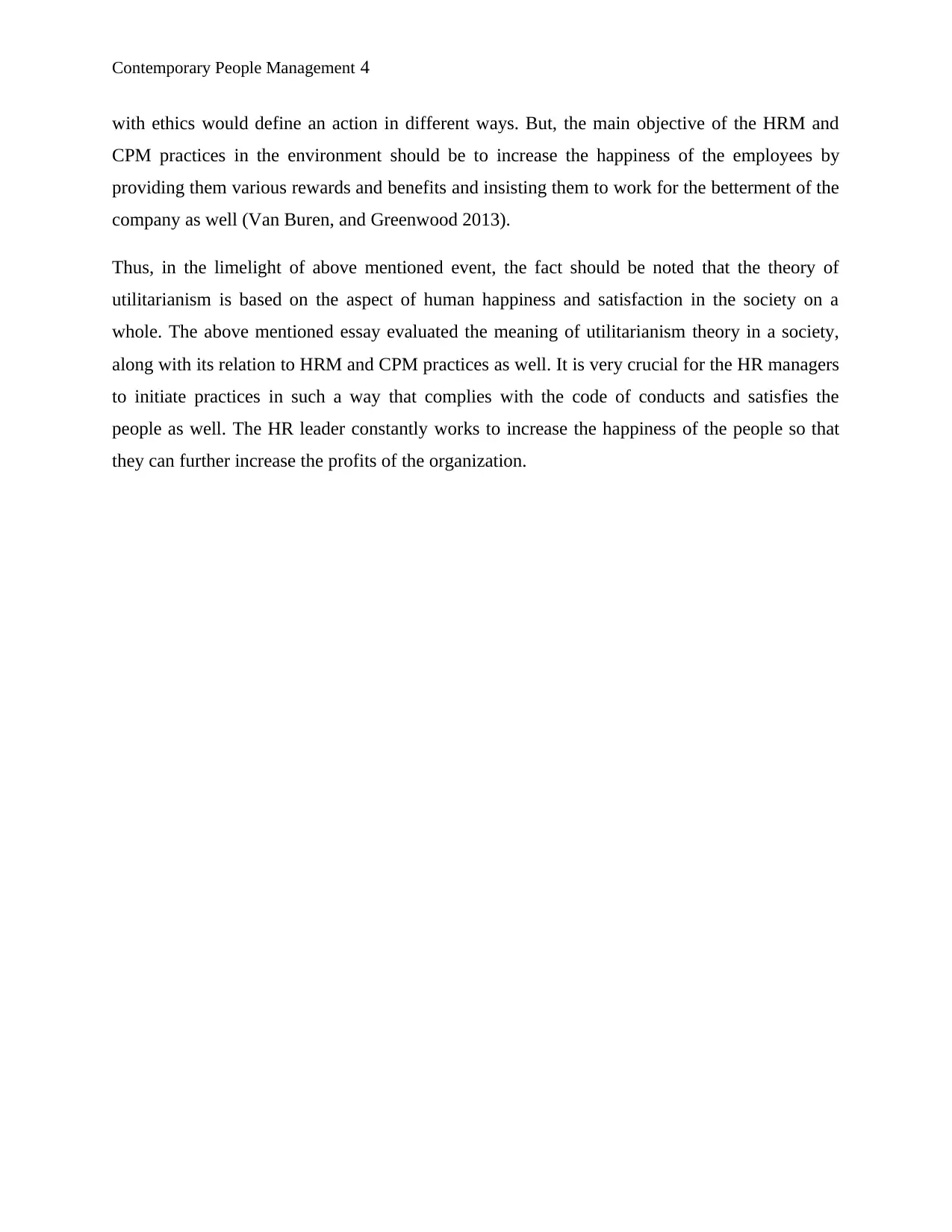
Contemporary People Management 4
with ethics would define an action in different ways. But, the main objective of the HRM and
CPM practices in the environment should be to increase the happiness of the employees by
providing them various rewards and benefits and insisting them to work for the betterment of the
company as well (Van Buren, and Greenwood 2013).
Thus, in the limelight of above mentioned event, the fact should be noted that the theory of
utilitarianism is based on the aspect of human happiness and satisfaction in the society on a
whole. The above mentioned essay evaluated the meaning of utilitarianism theory in a society,
along with its relation to HRM and CPM practices as well. It is very crucial for the HR managers
to initiate practices in such a way that complies with the code of conducts and satisfies the
people as well. The HR leader constantly works to increase the happiness of the people so that
they can further increase the profits of the organization.
with ethics would define an action in different ways. But, the main objective of the HRM and
CPM practices in the environment should be to increase the happiness of the employees by
providing them various rewards and benefits and insisting them to work for the betterment of the
company as well (Van Buren, and Greenwood 2013).
Thus, in the limelight of above mentioned event, the fact should be noted that the theory of
utilitarianism is based on the aspect of human happiness and satisfaction in the society on a
whole. The above mentioned essay evaluated the meaning of utilitarianism theory in a society,
along with its relation to HRM and CPM practices as well. It is very crucial for the HR managers
to initiate practices in such a way that complies with the code of conducts and satisfies the
people as well. The HR leader constantly works to increase the happiness of the people so that
they can further increase the profits of the organization.
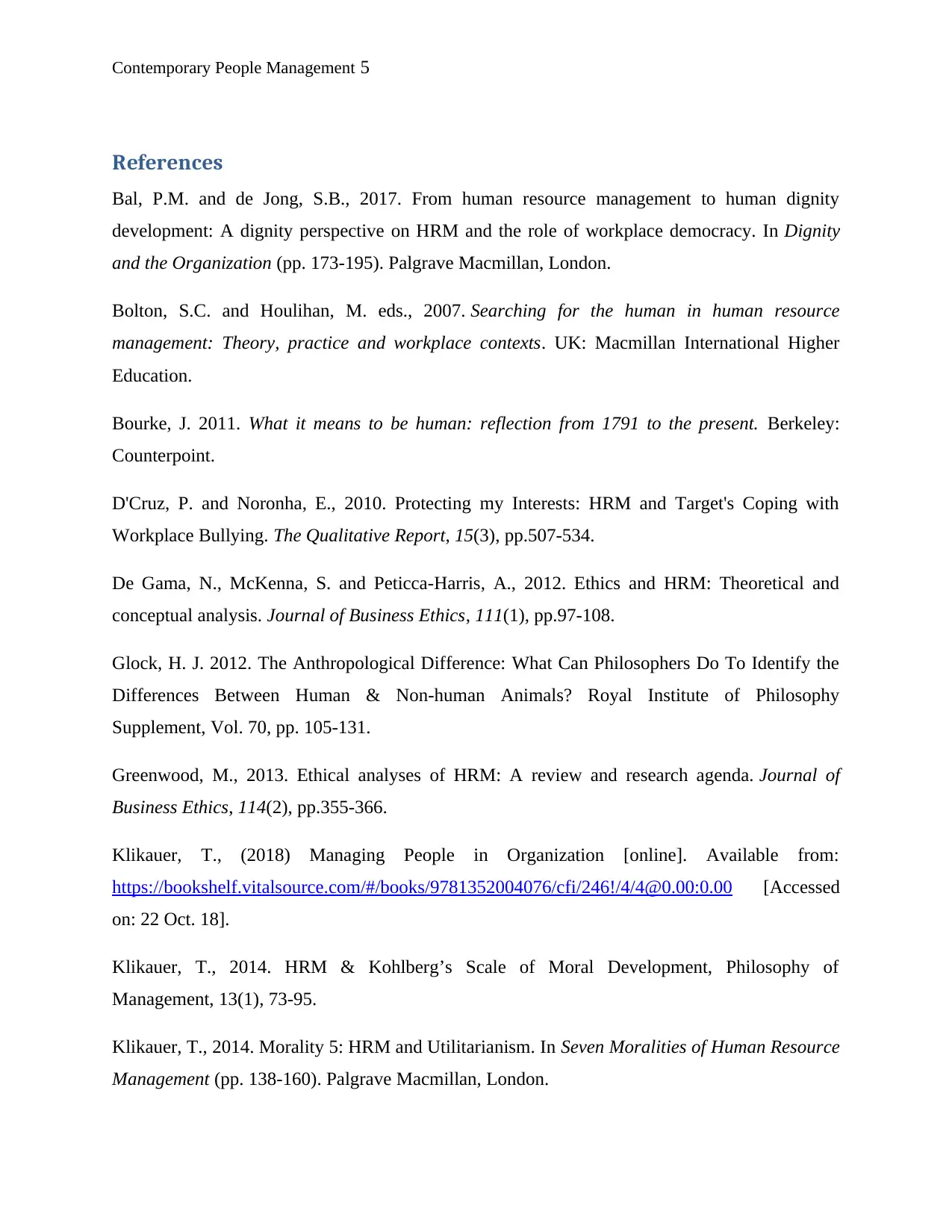
Contemporary People Management 5
References
Bal, P.M. and de Jong, S.B., 2017. From human resource management to human dignity
development: A dignity perspective on HRM and the role of workplace democracy. In Dignity
and the Organization (pp. 173-195). Palgrave Macmillan, London.
Bolton, S.C. and Houlihan, M. eds., 2007. Searching for the human in human resource
management: Theory, practice and workplace contexts. UK: Macmillan International Higher
Education.
Bourke, J. 2011. What it means to be human: reflection from 1791 to the present. Berkeley:
Counterpoint.
D'Cruz, P. and Noronha, E., 2010. Protecting my Interests: HRM and Target's Coping with
Workplace Bullying. The Qualitative Report, 15(3), pp.507-534.
De Gama, N., McKenna, S. and Peticca-Harris, A., 2012. Ethics and HRM: Theoretical and
conceptual analysis. Journal of Business Ethics, 111(1), pp.97-108.
Glock, H. J. 2012. The Anthropological Difference: What Can Philosophers Do To Identify the
Differences Between Human & Non-human Animals? Royal Institute of Philosophy
Supplement, Vol. 70, pp. 105-131.
Greenwood, M., 2013. Ethical analyses of HRM: A review and research agenda. Journal of
Business Ethics, 114(2), pp.355-366.
Klikauer, T., (2018) Managing People in Organization [online]. Available from:
https://bookshelf.vitalsource.com/#/books/9781352004076/cfi/246!/4/4@0.00:0.00 [Accessed
on: 22 Oct. 18].
Klikauer, T., 2014. HRM & Kohlberg’s Scale of Moral Development, Philosophy of
Management, 13(1), 73-95.
Klikauer, T., 2014. Morality 5: HRM and Utilitarianism. In Seven Moralities of Human Resource
Management (pp. 138-160). Palgrave Macmillan, London.
References
Bal, P.M. and de Jong, S.B., 2017. From human resource management to human dignity
development: A dignity perspective on HRM and the role of workplace democracy. In Dignity
and the Organization (pp. 173-195). Palgrave Macmillan, London.
Bolton, S.C. and Houlihan, M. eds., 2007. Searching for the human in human resource
management: Theory, practice and workplace contexts. UK: Macmillan International Higher
Education.
Bourke, J. 2011. What it means to be human: reflection from 1791 to the present. Berkeley:
Counterpoint.
D'Cruz, P. and Noronha, E., 2010. Protecting my Interests: HRM and Target's Coping with
Workplace Bullying. The Qualitative Report, 15(3), pp.507-534.
De Gama, N., McKenna, S. and Peticca-Harris, A., 2012. Ethics and HRM: Theoretical and
conceptual analysis. Journal of Business Ethics, 111(1), pp.97-108.
Glock, H. J. 2012. The Anthropological Difference: What Can Philosophers Do To Identify the
Differences Between Human & Non-human Animals? Royal Institute of Philosophy
Supplement, Vol. 70, pp. 105-131.
Greenwood, M., 2013. Ethical analyses of HRM: A review and research agenda. Journal of
Business Ethics, 114(2), pp.355-366.
Klikauer, T., (2018) Managing People in Organization [online]. Available from:
https://bookshelf.vitalsource.com/#/books/9781352004076/cfi/246!/4/4@0.00:0.00 [Accessed
on: 22 Oct. 18].
Klikauer, T., 2014. HRM & Kohlberg’s Scale of Moral Development, Philosophy of
Management, 13(1), 73-95.
Klikauer, T., 2014. Morality 5: HRM and Utilitarianism. In Seven Moralities of Human Resource
Management (pp. 138-160). Palgrave Macmillan, London.
⊘ This is a preview!⊘
Do you want full access?
Subscribe today to unlock all pages.

Trusted by 1+ million students worldwide
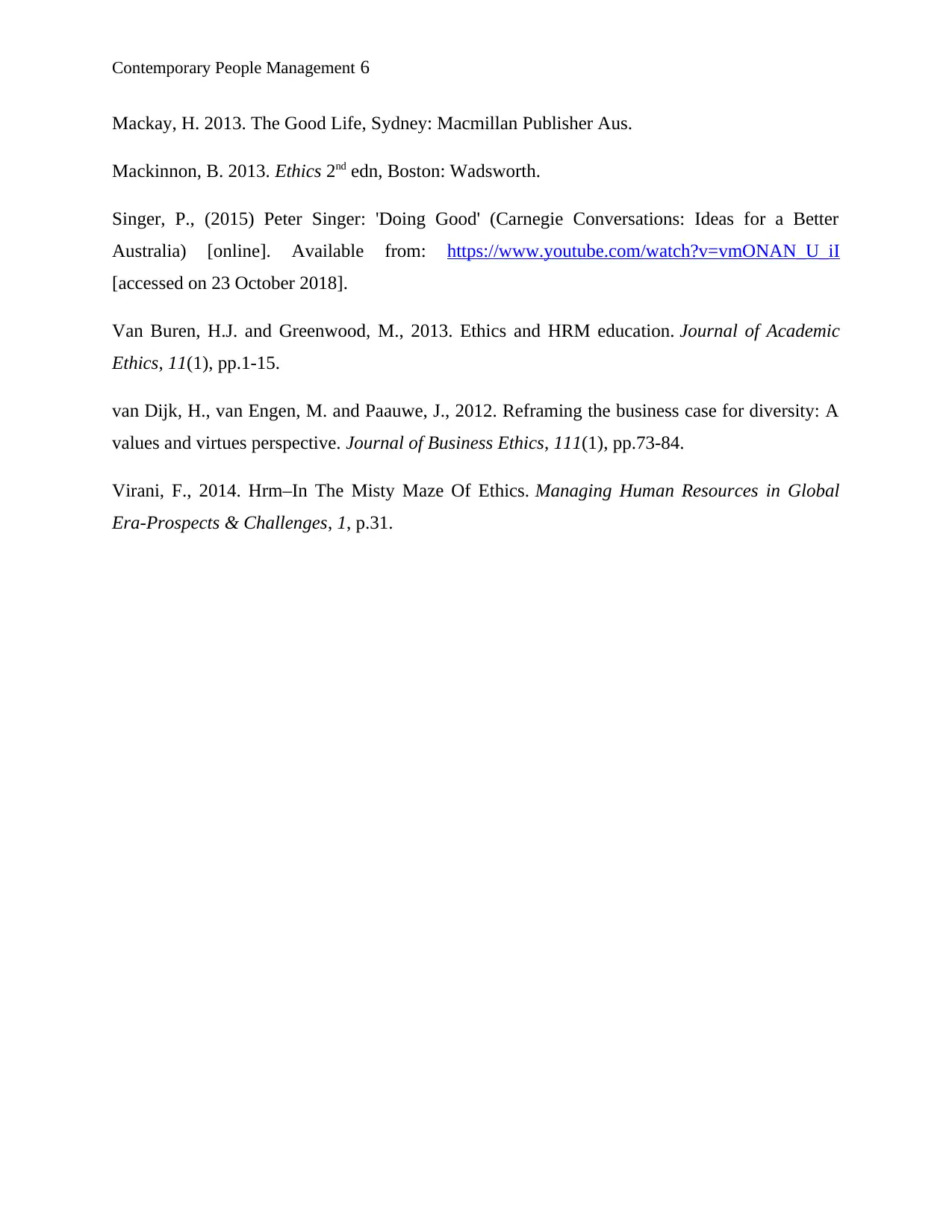
Contemporary People Management 6
Mackay, H. 2013. The Good Life, Sydney: Macmillan Publisher Aus.
Mackinnon, B. 2013. Ethics 2nd edn, Boston: Wadsworth.
Singer, P., (2015) Peter Singer: 'Doing Good' (Carnegie Conversations: Ideas for a Better
Australia) [online]. Available from: https://www.youtube.com/watch?v=vmONAN_U_iI
[accessed on 23 October 2018].
Van Buren, H.J. and Greenwood, M., 2013. Ethics and HRM education. Journal of Academic
Ethics, 11(1), pp.1-15.
van Dijk, H., van Engen, M. and Paauwe, J., 2012. Reframing the business case for diversity: A
values and virtues perspective. Journal of Business Ethics, 111(1), pp.73-84.
Virani, F., 2014. Hrm–In The Misty Maze Of Ethics. Managing Human Resources in Global
Era-Prospects & Challenges, 1, p.31.
Mackay, H. 2013. The Good Life, Sydney: Macmillan Publisher Aus.
Mackinnon, B. 2013. Ethics 2nd edn, Boston: Wadsworth.
Singer, P., (2015) Peter Singer: 'Doing Good' (Carnegie Conversations: Ideas for a Better
Australia) [online]. Available from: https://www.youtube.com/watch?v=vmONAN_U_iI
[accessed on 23 October 2018].
Van Buren, H.J. and Greenwood, M., 2013. Ethics and HRM education. Journal of Academic
Ethics, 11(1), pp.1-15.
van Dijk, H., van Engen, M. and Paauwe, J., 2012. Reframing the business case for diversity: A
values and virtues perspective. Journal of Business Ethics, 111(1), pp.73-84.
Virani, F., 2014. Hrm–In The Misty Maze Of Ethics. Managing Human Resources in Global
Era-Prospects & Challenges, 1, p.31.
1 out of 7
Related Documents
Your All-in-One AI-Powered Toolkit for Academic Success.
+13062052269
info@desklib.com
Available 24*7 on WhatsApp / Email
![[object Object]](/_next/static/media/star-bottom.7253800d.svg)
Unlock your academic potential
Copyright © 2020–2025 A2Z Services. All Rights Reserved. Developed and managed by ZUCOL.





